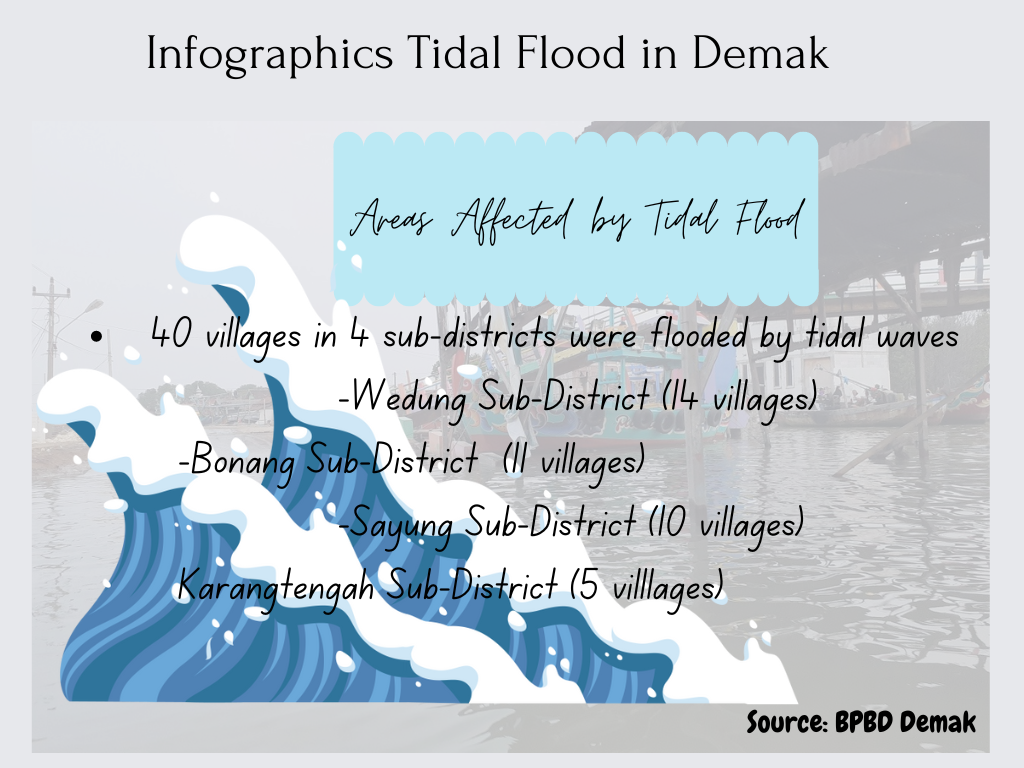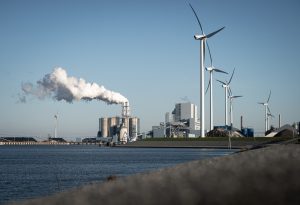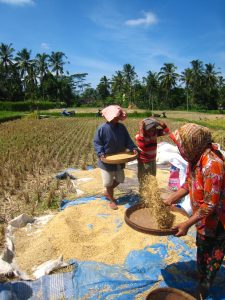
by: Hartatik
Demak—Early warnings of high waves due to sea tides released by the Meteorological, Climatology and Geophysics (BMKG) Maritime Semarang office in the past week seemed commonplace for residents on the coast of Demak Regency. They have lived under the siege of rob or tidal waves for years.
Even in a day, the tidal wave can occur twice. Tens of thousands of residents who live in Sayung, Karangtengah, Bonang, and Wedung sub-districts feel this condition. Data collected from the Demak Regional Disaster Management Agency (BPBD) shows that at least 40 villages in the three sub-districts are now subject to tidal floods when the tide is high, with the height of water entering residential areas varying from 20 centimetres to one meter.
For example, in Dukuh Pongangan, Purworejo Village, Bonang Subdistrict, the height of the tidal wave when there is no lunar eclipse is only around 10-30 centimetres. However, when there is a super blood moon or supermoon phenomenon, the height of the tidal wave can reach more than one meter.
“Every day, the tidal wave in Purworejo Village is like this. Even if it recedes, it is only for a short time. Like today, the tidal wave rises and peaks in the afternoon. At night, it recedes, but in the afternoon, it starts to rise again,” said Zaenudin (54), a resident of Dukuh Pongangan.
Not a few motorcycles broke down in the middle of the road because their exhaust was filled with seawater. Village transportation that dares to cross the tidal inundation can also be counted on the fingers. It is not uncommon for minibuses to turn around because the height of the tidal floods makes it impossible to cross. Only becak montor or bentor (motorised tricycles) dared to cross the flood.
For fishermen and pond farmers, the losses suffered due to tidal floods are multiple. In addition to houses and vehicles becoming easily damaged, the selling price of catches and pond harvests plummets. The selling price can drop by up to 20 per cent.
“The reason for the middlemen is that the 20 per cent is for transportation costs because not many vehicles want to cross the tidal inundation area,” he added.
Tidal flooding seems to have become a familiar friend for fishermen and aquaculture farmers along the coast of Pantura. The water submerges their houses and ponds for days, weeks, months and even years.
Tidal flooding is a bad story that haunts the residents of the Demak region. Coastal residents have suffered endlessly from overflowing sea tides until now.

40 villages affected by abrasion
Tidal floods have inundated at least 40 villages in 4 coastal sub-districts due to worsening abrasion. These include 14 villages in the Wedung Subdistrict, 11 villages in the Bonang Subdistrict, 10 in the Sayung Subdistrict, and five in the Karangtengah Subdistrict.
The tidal floods drowned two hamlets in Sayung Subdistrict, Senik and Tambaksari. A total of 208 families had to be relocated to other safer villages. The two hamlets have become mangrove forests, and thousands of cranes now inhabit them.
Morodemak Village Secretary Mohammad Syaifudin (55) said that almost all of the land in Morodemak, Bonang Subdistrict, is currently affected by tidal floods. Furthermore, in his village, which has a population of 6,800, most of the roads, villages, and houses have been flooded.
“Morodemak has 32 RTs and 5 RWs. Almost all of them are submerged now. Around 90 per cent of the houses have been affected by the tidal wave,” he explained.
Syaifudin continued, “Seawater overflow in Morodemak Village occurs every month. Previously, tidal flooding only occurred in his village for about four months a year.” He also said that the sea tide that inundated his area came at erratic times.
“It used to happen in April, May, June, July, but now it comes every month. Between an estimated 10-15 days a month with a height of 30-70 cm,” he added.
Syaifudin continued, “Seawater overflow in Morodemak Village occurs every month. Previously, tidal flooding only occurred in his village for about four months a year.” He also said that the sea tide that inundated his area came at erratic times.
“It used to happen in April, May, June, July, but now it comes every month. Between an estimated 10-15 days a month with a height of 30-70 cm,” he added.

In addition, the arrival of sea tides each month is erratic in a day. Sometimes it comes in the morning, afternoon, afternoon and evening. The duration of seawater overflowing into the land is about five hours. Syaifudin suspects that one of the factors causing the tidal flooding in Morodemak Village to get worse is the construction or elevation of the district’s main road in Purworejo Village to the Fish Auction Site (TPI).
“Before the construction of the road, the tidal floods could be divided, but now all tidal floods go to Morodemak. But since 2018, tidal flooding has occurred every month,” he said.
Nevertheless, his party admits that they elevate the road every year. He admits that he often can’t do anything when he sees his residents surrounded by tidal floods, which are more dangerous than floods. Public facilities are damaged, and residents’ buildings are easily destroyed at the slightest shake.
“Flooding due to rain or river overflow is destructive, but only when it happens. Meanwhile, rob, which occurs in the form of inundation for years, will cause corrosion. Soil subsides, buildings become porous and eventually collapse,” said Sugiyanto (50), a resident of Morodemak.
Mansur (45), a resident of Purworejo Village, complained that the access to the Morodemak fish auction site (TPI) is submerged by tidal floods daily. The height of the flood can vary, reaching up to 70 cm. As a result of the tidal flooding that occurs every day, Mansur said, residents have to pay additional costs to use boats, which residents commonly call nambang perahu. Using a boat for one trip is IDR 4,000 (USD 0.26) per person.
“Children go to school for IDR 4,000. If there are three children, IDR 12,000 (USD 0.77). Not to mention the father, if the family is not just once, it can be multiplied,” he explained.
In addition, tidal flooding conditions quickly damage motorised vehicles.
“Motorcycle brake pads last three months at most, as do gears and others,” explained Mansur.
“It’s really bad (tidal flooding). The worst is in the last three years,” he complained.
Also, the residents have to raise their houses every year due to tidal flooding. Mansur admitted that he had raised his house four times.
“In 2017, I raised my house to 80 cm, and now it is sinking. I raised the house four times, 50 cm-80 cm. Three years it sinks, four years at most,” he said.
Mukholidin, chairman of RW 3 Purworejo Village, said that the public road in Purworejo Village has been submerged in water for about five kilometres from the village border to the Fish Auction Place (TPI).
“It has been submerged in seawater since the last two months,” he said.
He said that public transportation does not dare to enter. As a result, residents must take bentor motorcycle taxis and spend IDR 5,000 (USD 0.32) one way. Rob submerges public roads, village roads, and alleys, as well as settlements in three villages, namely Purworejo, Morodemak, and Margolinduk, every year.
“This year’s flood is the biggest. The previous year, it could be controlled in two hours, while this year, it can last all day, from 8 am to 9 pm,” he said.
In addition, he said residents had to raise the foundations of their houses and repair motorcycles due to frequent exposure to seawater. Furthermore, residents would rather take a boat than continuously brave the tidal wave with a motorised vehicle.

Not a disaster
Although the suffering of coastal residents from sea tides seems endless, the irony is that rob is not considered a disaster. Head of the Demak Regional Disaster Management Agency (BPBD), Agus Nugroho Luhur Pambudi, regrets that there are rules that hamper efforts to deal with tidal floods in Demak.
“In Law No. 4/2007, tidal floods that inundate people’s homes are not considered a natural disaster. BPBD and BNPB cannot do anything because the regulation does not include the criteria for disaster,” said Agus.
He even urged the central government, Central Java Provincial Government and Demak Regency Government to coordinate to deal with the current tidal floods. Moreover, his party has repeatedly reminded the Provincial Government and related ministries so that the tidal floods can be overcome immediately.
The insistence was fruitful, as 2025 IDR 500 billion (USD 32.15 million) was disbursed from the state budget to construct sea walls in the Sayung District area. The sea wall was built to prevent tidal floods in the Sayung Subdistrict, which affected the Pantura Road.
Demak Regent Eisti’anah said that the construction of the sea dike polder system was following the proposal of the Demak Regency Government, which had previously coordinated with Bappenas. Even the DED of this sea wall has been prepared since 2023.
“All districts/cities (affected by tidal floods) exposed to the province received a total budget of IDR 2 trillion (USD 128.59 million), and Demak received IDR 500 billion (USD 32.15 million) for a special sea wall in Sayung. The realisation will be in 2025,” said the Regent.
He continued that the Demak Regency Government is still lobbying the centre to connect the sea wall to Wedung District on the border with Jepara Regency.
Separately, the civil society coalition incorporated in Maleh Dadi Segoro assessed that the environmental impact assessment (EIA) of the Semarang-Demak sea wall toll road had some weaknesses.
One is the lack of in-depth study of potential changes in sea currents, land subsidence, and the history of tidal floods.
“Regarding the potential changes in sea currents, it turns out that the EIA study is only limited to the construction stage and is only hypothetical in nature,” said Iqbal Alma Alghofani, Dynamic Coordinator of the Maleh Dadi Segoro Coalition.
The Advocacy and Campaign Manager of Wahana Lingkungan Hidup (Walhi) Central Java said that the contour of the land in Demak consists of clay that has only solidified in the last hundred years.
Demak has lost 5 km of coastline due to tidal flooding, which is also influenced by the presence of rivers. According to him, constructing sea walls is not the right solution to overcome tidal flooding.
This is because the embankment’s construction is made of concrete, and its nature is to exert pressure. Meanwhile, seawater will rise due to the climate crisis, and the land surface is decreasing.
“Environmental damage in the north coast of Java is the accumulation of policies that are not pro-environment.
Furthermore, according to him, the construction of the sea wall toll road is also considered to impact 46 hectares of mangrove forest areas and threaten several people’s livelihoods.
“Shrimp and crab farmers along the Semarang-Demak coastal area are the most affected due to the reduction of mangrove forest areas and the acquisition of pond land,” he said.
Walhi noted that in 2020, at least 109 villages in Central Java and 1,148 villages in Indonesia were submerged. Due to rising sea levels, at least one hectare of land is lost along the Demak coastal area annually.
Banner photo: Tidal flood inundates road access and residential areas in Purworejo Village, Bonang Subdistrict, Demak Regency. (Hartatik)













